
Finding Direction with No Compass
There are lots of fun ways to find directions if you've lost or forgotten your compass. They are great exercises to do just to learn them and have handy just in case or to impress your city-slicker friends. These methods can be used to map cardinal directions and better, but remember that they are not nearly as good as a compass.
Polaris the North Star
This is my favorite and the easiest one to do. All you need is a fairly clear night and knowledge of a couple constellations.
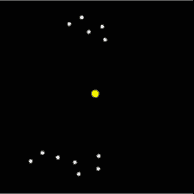
- Find the Big Dipper in the sky.
- Follow the edge of the ladle 5 times its length up the edge of the ladle.
- The brightest star there is Polaris the North Star which is virtually north.
- Cassiopeia is a 'W' shaped constellation across the North Star from the Big Dipper. It's 'W' points right at the north star also.
- In the southern hemisphere, the Southern Cross is used to indicate South similarly to Polaris.
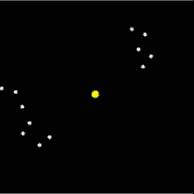
Watch Method
In the days of digital watches, this one is fading away.
- Hold your wristwatch in front of you like a compass.
- Hold a toothpick or little twig or piece of grass up along the edge of your watch so it casts a shadow toward the center of the watch.
- Turn your watch until the shadow splits in half the distance between the hour hand and 12 on the watch face.
- 12 is now pointing South and 6 is pointing North. (In the Southern hemisphere, 12 points North and 6 points South.)

If you only have a digital watch, phone, or similar, use your imagination.
- Draw a big circle in the dirt with a stick.
- From the center of the circle, draw a line straight towards the sun. (this is your hour hand)
- Now, draw a line to 12 on the circle where it would be in relation to the hour hand.
- Halfway between the two lines is South. (In the Southern Hemisphere, halfway between the lines is pointing North.)

Sun Shadow Method
The sun moves across the sky from east to west and its shadow gradually changes in length which is what makes this direction finding method work.
- Clear a flat area of dirt or sand. Grass will work, but not as well.
- Find a stick about 2 or 3 feet long and stick poke it into the ground so it stands up.
- Get another small stick or pebble and place it exactly on the end of the shadow line.
- Eat a trail bar or relax for a half hour.
- Place another stick or pebble at the end of the new shadow. If you have time, wait another 1/2 hour and repeat.
- The line between the two pebbles runs east-west direction with the first mark being west and the second being east.
- If you are in the northern hemisphere, North direction is perpendicular to the east-west line heading away from the sun. (In the Southern Hemisphere, that line pointing away from the sun is pointing South.)

A cool variation on this is that it works well at night with a bright moon too!
There is a similar version that is more precise if you have a few hours to wait, but the difference in precision is not worth the wait - its mostly just for fun and takes two people.
- Clear a flat area of dirt or sand. Grass will work, but not as well.
- Find a stick about 2 or 3 feet long and stick poke it into the ground so it stands up.
- Get a piece of string or rope or a stick that is the length of the current shadow.
- Have your buddy hold the string at the base of the shadow stick while you scratch a circle in the dirt around the shadow stick using the string as the radius guide.
- Mark the spot where the shadow is currently hitting the circle.
- Go fishing, sleep, or waste the next hour or so.
- Check on the shadow and notice that it is shorter and has moved to the east. Continue to check the shadow until it is again long enough to touch the circle. This may take an hour or 6 hours, depending on how early you set it up.
- Drawing a line between the original shadow point and the current shadow will be West to East.
- If you are in the northern hemisphere, the cardinal direction North is perpendicular to the east-west line heading away from the sun. ( In the Southern Hemisphere, that line pointing away from the sun is pointing South.)
- Any two shadow points the same distance from the shadow stick will make an east-west line.
Moon Method
Besides using the moon's shadow just like the sun shadow method above, a partial moon also points the way.
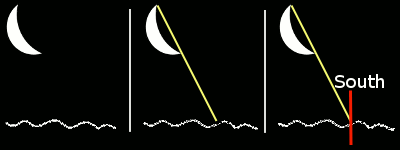
- Notice the two points on the moon when it is not full.
- Follow an imaginary line between the two points down to the horizon.
- Where the line hits the horizon is approximately South. (In the Southern Hemisphere, it is North.)
Star Method
If you can't find the Big Dipper because it is behind a mountain, or behind clouds this method can help if you can see some stars in the sky:
- Two Sticks:
- Find a tall stick about 3 or 4 feet high and stick it in the ground.
- Sit on the ground by the stick.
- Using another stick about 2 feet long, sight the tops of both sticks to a bright star and stick the shorter stick in the ground.

- One Stick:
- Using a tent pole or other straight stick, position it on a tall rock or on a tree limb so it is steady.
- Stand or lay in a position and location that you can copy later. A good example is laying against the rock with your chin on your fist and mark your fist location on the rock with chalk or a rock scratch.
- Sight up the stick at a bright star that you can recognize later.

- Come back in a half hour and notice which direction the star has moved. You may want to check this at 15 minute intervals for an hour.
- If the star has moved to the right, you are facing south.
moved Left = facing North
moved Up = facing East
moved Down = facing West - The star will most likely have moved up and right or down and right so you will need to estimate the direction, such as SouthEast or SouthWest.
How to Make a Compass
If you happen to be out on a trek and realize that you forgot your compass but happen to have a magnet and a needle or nail in your pocket, I'll tell you how to make a compass. Chances of this ever being used in a real situation are slim, but it's a fun thing to do just so you know how to do it.
- Get a big sewing needle or a very small nail and a bar magnet. Also get some thread or a bowl of water and two tiny pieces of cork.
- Hold the needle in one hand and the magnet in the other.
- Put the North end of the magnet against the needle in the middle and rub it towards and off the point.
- Lift the magnet up and away from the needle and place it in the middle again.
- Repeat rubbing the North end of the magnet against one half of the needle 20 times or so.
- Flip the magnet over so you are using the South end and rub it from the middle to the 'eye' end of the needle 20 times.
- You have magnetized the needle just like a compass needle.
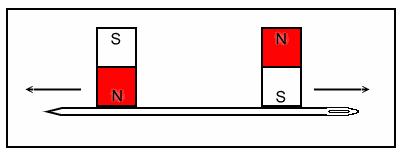
- Hanging Compass:
- Tie one end of a length of thread to a stick and the other end to the middle of the needle. Or, tie it like the image for easier balancing.
- Let the needle hang freely and slide the thread to a point on the needle where it balances level.
- Lower the needle into a wide-mouthed jar and lay the stick across the opening to prevent wind interference.
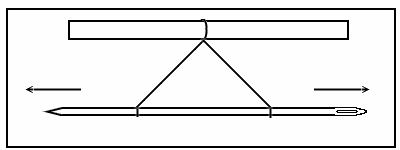
- Floating Compass:
- Stick a tiny piece of cork on each end of the needle so it floats.
- Place the needle on the water in a small bowl.
- Wrap a layer of plastic wrap over the bowl to prevent wind currents for better accuracy.
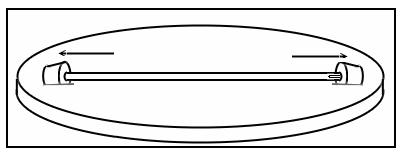
- Watch which way your compass needle turns. It should always settle to the same direction.
This is the last page in my map and compass tutorial. If you've started at the beginning and gone through the whole thing, you should have a good idea about how compasses work and how maps help us along the way. I hope you've enjoyed your trek. I also hope you take a shot at finding cardinal directions and Polaris the north star and let me know what worked for you.
Now, you just need to go practice and plan your next excursion out of your cubicle, away from your computer screen, and into the real world that's waiting out there!
 What kind of elephants live at the north pole?
What kind of elephants live at the north pole?
Cold ones! |
| Search Google News for more 'Lost Hiker' news items. |
| 08 Dec 2025 - Hiker who set out to climb Mount Whitney for 21st birthday missing 3 weeks later |
| 30 Oct 2025 - Returning to the Appalachian Trail After the Murder That Changed It |
| 05 Dec 2025 - Mount Whitney hiker missing for 3 weeks feared dead |
| 04 Dec 2025 - Sitka Search and Rescue assists lost hiker in early hours of the morning |
| 17 Nov 2025 - Old Hiker Missing From Appalachian Trail Intensifies |
| 24 Nov 2025 - Lost Hikers on Mt. Monadnock in Jaffrey |
Comments:
Feb 13, 2016 - Mark Johnson
I love these alternative methods for finding direction without a compass, but I had to crack-up a bit at the Shadow Method. How would I know it's 4pm if I don't have a watch? You need to write another column "How do you find out what time it is without a watch" :)
If you know the Lat/Lon of your destination, then you can figure out your current Lat/Lon and then the direction to travel to reach your destination. To do this is VERY complicated and not realistic for someone dropped in a random location. Try this page as a start.
I have a question about the watch method. Since the watch is based on 12 hours, is the watch method accurate near the summer solstice when the there is 14 hours of sunlight, and near the winter solstice when there is only 10 hours of sunlight? Is there any type of correction needed during these times of the year?
Ask a Question
More Map and Compass Resources at CompassDude.com



Recent Comments